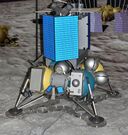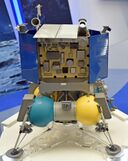Organization:International Lunar Research Station
| Country | China , Russia |
|---|---|
| Organization | CNSA, Roscosmos |
| Purpose | Crewed lunar exploration and research |
| Program history | |
| Duration | Reconnaissance: 2021–2025 Construction: 2026–2035 Utilization: from 2036 |
The International Lunar Research Station (ILRS) (Chinese: 国际月球科研站) is a planned lunar base currently being developed by Roscosmos and the China National Space Administration (CNSA), with other partners planning to join later on. The ILRS will serve as a comprehensive scientific experiment base built on the lunar surface or in lunar orbit that can carry out multi-disciplinary and multi-objective scientific research activities including exploration and utilization, lunar-based observation, basic scientific experiment and technical verification, and long-term autonomous operation. Statements from Roscosmos and CNSA underline that the project will be "open to all interested countries and international partners."[1][2][3][4]
History
On 16 June 2021, Roscosmos and the China National Space Administration (CNSA) held a joint session in St. Petersburg on the auspices of the Global Space Exploration Conference (GLEX 2021), dedicated to the presentation of the Roadmap for the creation of the International Lunar Research Station (ILRS). The session was attended by Sergei Saveliev, the Deputy Director General of Roscosmos for International Cooperation and Wu Yanhua, the Vice Administrator of CNSA (remotely).
Roscosmos and CNSA representatives held consultations on a draft declaration in September 2021, together with experts from Germany , France , Italy, the Netherlands, Malaysia, Thailand and the UN Office for Outer Space Affairs. The talks took place behind closed doors.[5]
Definition and composition
ILRS is a complex experimental research facility to be constructed with a possible attraction of partners on the surface and/or in the orbit of the Moon designed for multi-discipline and multi-purpose scientific research activities, including exploration and use of the Moon, Moon-based observation, fundamental research experiments, and technology verification with the capability of long-term unmanned operation with the prospect of subsequent human presence.[6]
Scientific objectives
- Lunar topography, geomorphology, and geological structure
- Lunar Physics and internal structure
- Lunar Chemistry (materials and geoarchaeology)
- Cis-Lunar space environment
- Lunar-based astronomical observation
- Lunar based Earth observation
- Lunar-based biological and medical experiment
- Lunar Resource in-situ utilization
Facilities
- Cislunar Transportation Facility – supporting round-trip transfers between the Earth and the Moon, including lunar descent, landing, ascent, and return to Earth.
- Long-term Support Facility on Lunar Surface – to consist of various support modules for operations on the lunar surface.
- Lunar Transportation and Operation Facility – to consist of modules for lunar exploration and cargo transportation.
- Lunar Scientific Facility – to support in-orbit and surface experiments
- Ground Support and Application Facility – data center and ground support operations
Development
Phase 1: Reconnaissance (2021–2025)
Objectives:[6]
- Lunar reconnaissance with the planned missions
- ILRS design and selection of site(s)
- Technology verification for a secure high-precision soft landing
Planned Missions
Most missions that are planned in the reconnaissance era weren't specifically planned for the ILRS, with some being planned far back into the 90's.[7] However, their reconnaissance can still prove useful to the overall mission.
Chang'e 4
Chang'e 4 was a soft landing on the far side of the Moon, Launched on the 7th of December, 2018, entering Lunar Orbit on 12 of December as a part of China's own Chinese Lunar Exploration Program. While not specifically made for the Research Station, as it was a backup module for its predecessor, Chang'e 3.[8] However, it has still helped with Reconnaissance for the mission as a whole, a theme for most reconnaissance missions for the Research Station.
Luna 25
Luna 25 is a planned mission to the Moon by Roscosmos to deliver 30 kg of scientific payloads and instruments to the surface of the Moon. It was not planned specifically for the Research Station, with planning going back all the way to 90's.[7]
Luna 26
Luna 26 is a planned lunar polar orbiter. Along with the scientific payload that it carries, it would allow for a telecom array for landed Russian assets, and Earth. The Mission was announced in November 2022, and it has a launch plan for 2024. It will study the lunar surface along with carrying foreign payloads from NASA, and the ESA.[9] It will also do some reconnaissance for the future Luna 27.
| Date | Country (Agency) | Launch Vehicle | Spacecraft | Image | Status |
|---|---|---|---|---|---|
| 7 December 2018 | LM-3B | Chang'e 4 | 
|
Successful | |
| 2023 | Soyuz-2 | Luna 25 | 
|
Planned | |
| 2025 | LM-5 | Chang'e 6 | Planned | ||
| 2026 | LM-5 | Chang'e 7 | Planned | ||
| 2027 | Soyuz-2 | Luna 26 | 
|
Planned | |
| August 2028 | Soyuz-2 | Luna 27 | 
|
Planned |
Phase 2: Construction (2026–2035)
- Technology verification for the command center of ILRS
- Lunar sample return
- Massive cargo delivery and secure high-precision soft landing
- Start of joint operations
- Establishment of in-orbit and surface facilities for the ILRS, in preparation for crewed missions.
| Missions | Objectives | Date | Country(Agency) | Launch Vehicle | Spacecraft | Image | Status |
|---|---|---|---|---|---|---|---|
| 2027 | LM-5 | Chang'e 8 | Planned | ||||
| 2027 | Angara A5 | Luna 28 | Planned | ||||
| 5 crucial missions planned for comprehensive establishment of ILRS to complete the in-orbit and surface facilities between 2030 and 2035 | |||||||
| ILRS-1 | "Establishment of the command center, basic energy, and telecommunication facilities, to satisfy the needs of lunar infrastructure, lunar autonomous operations, and long-term research exploration."[6] |
2031 | TBA | LM-9 or Yenisei | TBA | Planned | |
| ILRS-2 | "Establishment of lunar research and exploration facilities such as lunar physics, geological profiling, lava tube exploration, lunar sample return."[6] |
2032 | TBA | LM-9 or Yenisei | TBA | Planned | |
| ILRS-3 | "Establishment of lunar in-situ resources utilization technology verification facilities."[6] |
2033 | TBA | LM-9 or Yenisei | TBA | Planned | |
| ILRS-4 | "Verification of the general technologies for the lunar biomedical experiment distributes sample collection and return."[6] |
2034 | TBA | LM-9 or Yenisei | TBA | Planned | |
| ILRS-5 | "Establishment of Lunar-based astronomy and earth observation capabilities."[6] |
2035 | TBA | LM-9 or Yenisei | TBA | Planned | |
Phase 3: Utilization (from 2036)
Objectives:[6]
- Lunar research, exploration, and technology verification
- Supporting crewed lunar missions with the completed ILRS
- Expanding and maintaining modules as needed
See also
References
- ↑ Jones, Andrew (9 March 2021). "China, Russia enter MoU on international lunar research station". SpaceNews. https://spacenews.com/china-russia-enter-mou-on-international-lunar-research-station/.
- ↑ "China and Russia to build lunar space station". BBC News. 10 March 2021. https://www.bbc.co.uk/news/world-asia-china-56342311.
- ↑ "China, Russia agree to build lunar research station". Associated Press. 10 March 2021. https://apnews.com/article/china-russia-build-lunar-research-station-45b749fb68ef65fd31e50d7e038050fe.
- ↑ @roscosmos (16 June 2021). "Видеоконцепция создания Международной научной лунной станции" (in ru). https://twitter.com/roscosmos/status/1405137294076559364.
- ↑ "Russia, China to present lunar station declaration at congress in Dubai late Oct". https://tass.com/science/1343047.
- ↑ 6.0 6.1 6.2 6.3 6.4 6.5 6.6 6.7 6.8 6.9 (PDF) International Lunar Research Station (ILRS) Guide for Partnership (1.0 ed.). CNSA & Roscosmos. 17 June 2021. https://www.roscosmos.ru/media/files/mnls.pdf. Retrieved 1 December 2022.
- ↑ 7.0 7.1 "Luna-Glob". http://www.russianspaceweb.com/luna_glob.html.
- ↑ Pearlman, Robert Z. (12 December 2018). "China's Chang'e 4 Moon Lander and Rover to Touch Down As Toys". Future US, Inc. Retrieved 15 November 2019.
- ↑ Foust, Jeff (2017-10-13). "NASA studying potential cooperation on Russian lunar science missions" (in en-US). https://spacenews.com/nasa-studying-potential-cooperation-on-russian-lunar-science-missions/.
- ↑ 10.0 10.1 Jones, Andrew (16 June 2021). "China, Russia reveal roadmap for international moon base". SpaceNews. https://spacenews.com/china-russia-reveal-roadmap-for-international-moon-base/.
 |


